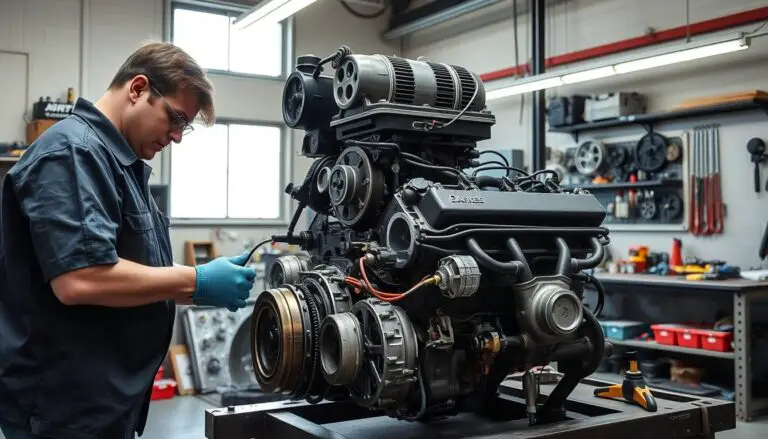A malfunctioning cigarette lighter can be a significant inconvenience, notably when it’s required for charging devices during travel. The prevalence of issues with the 12-volt outlet in vehicles is widespread, yet the resolution is frequently uncomplicated.
This piece aims to elucidate the typical reasons behind a non-functional cigarette lighter and offer a detailed, step-by-step approach to troubleshooting and rectification. We will address the spectrum of problems, from a blown fuse to a deteriorated lighter element, ensuring your cigarette lighter is restored to optimal functionality.
Key Takeaways
- Diagnose the issue with your car’s 12-volt outlet
- Learn how to replace a blown fuse
- Inspect and clean the socket for better connectivity
- Check the wiring for any damage or wear
- Replace the cigarette lighter element if necessary
Understanding Your Car’s Cigarette Lighter System
To rectify a malfunctioning car cigarette lighter, a thorough comprehension of its operational mechanics is imperative. The car’s cigarette lighter is an integral component of a broader electrical framework, tasked with powering an array of accessories.
How Car Cigarette Lighters Function
Car cigarette lighters operate by initiating an electrical circuit upon activation. This process enables the flow of electrical current through a heating element, culminating in its ignition. The resultant heat emanates, facilitating the lighting of a cigarette.
Components of a Cigarette Lighter Circuit
The cigarette lighter circuit encompasses several critical components, each indispensable to its functionality. These include the fuse, which serves as a protective barrier against electrical overloads; the wiring, which facilitates connectivity to the vehicle’s electrical system; the socket, the receptacle for the lighter; and the heating element, responsible for generating the requisite heat.
- The fuse acts as a safety device to prevent electrical overload.
- The wiring connects the lighter to the car’s electrical system.
- The socket is where you insert the lighter.
- The heating element is responsible for generating heat.
The Dual Purpose: Power Source and Lighter
Contemporary car cigarette lighters embody a dual functionality, serving both as a means to ignite cigarettes and as power outlets for device charging. This versatility is attributed to the design of the lighter socket, which enables continuous power supply.

Common Reasons Why Your Car Cigarette Lighter Not Working
When the car’s cigarette lighter fails to function, several potential causes must be explored. Identifying the root cause is essential for implementing an effective solution.
Blown Fuses: The Most Common Culprit
A blown fuse is frequently the primary cause of a malfunctioning car cigarette lighter. Fuses serve as a protective mechanism against electrical circuit damage from excessive current flow. Upon blowing, they interrupt the power supply to the cigarette lighter.
- Inspect the car’s fuse box for a blown fuse associated with the cigarette lighter circuit.
- Replace the fuse with a new one of identical amperage rating if required.
Socket Damage and Debris
Damage to the cigarette lighter socket or debris accumulation can impede its functionality. Examine the socket for any signs of damage or blockage.

Wiring Issues Behind the Socket
Wiring issues behind the socket can also contribute to malfunctions. Wires may deteriorate due to heat, abrasion, or corrosion, resulting in a loss of power to the cigarette lighter.
- Inspect the wiring behind the socket for any signs of damage.
- Repair or replace damaged wires as necessary.
Power Distribution Problems
At times, the problem may stem from the power distribution system rather than the cigarette lighter or its wiring. Issues such as a faulty ignition switch or alternator problems can impact the power supply.
- Investigate any other electrical issues in your vehicle that might be connected.
- Seek professional assistance if diagnosing power distribution problems is uncertain.
Tools and Materials You’ll Need for Diagnosis and Repair
Initiating the diagnosis and repair of your vehicle’s cigarette lighter necessitates the compilation of requisite tools and materials. The acquisition of appropriate equipment is paramount, facilitating a seamless process and ensuring your safety amidst electrical component manipulation.
Basic Tools Required
The commencement of diagnosing and repairing your car’s cigarette lighter necessitates the possession of fundamental tools. These include:
- A multimeter for testing voltage and continuity
- A screwdriver set (both flathead and Phillips) for accessing the fuse box and socket
- Needle-nose pliers for handling small components and wires
- Wire strippers for removing insulation from wires
Optional Specialized Tools
Though not indispensable, the utilization of specialized tools can significantly enhance the efficiency and ease of the repair process. These tools include:
- A fuse puller for safely removing fuses from the fuse box
- A socket tester for checking the cigarette lighter socket’s functionality
Safety Equipment
Ensuring safety is paramount when engaging with electrical systems. It is imperative to possess the following safety equipment:
- Safety glasses to protect your eyes from debris or electrical sparks
- Gloves to prevent electrical shock and improve grip on tools
Safety Precautions Before You Begin
Ensuring your safety is paramount when attempting to fix your car’s cigarette lighter. Working with electrical components can be hazardous if you’re not properly prepared. It’s essential to understand the risks involved and take necessary precautions to avoid injury or damage to your vehicle.
Disconnecting the Battery
One of the first steps in ensuring your safety is to disconnect the battery. This prevents any accidental short circuits that could cause injury or damage. To do this, locate your car’s battery and loosen the nut on the negative (black) cable clamp using a wrench. Once loose, pull the clamp off the negative terminal and secure it away from the battery to prevent it from coming into contact with the terminal again.
Working with Electrical Components Safely
When handling electrical components, it’s crucial to be mindful of the potential for electrical shock. Always use insulated tools to prevent conduction. Never touch electrical components with bare hands, as this can lead to severe injury. If you’re unsure about any part of the process, consider consulting a professional mechanic.
“Safety is not just a precaution, it’s a necessity when working with electrical systems.”
Preventing Dashboard Damage
When working on your car’s electrical system, it’s also important to prevent damage to your dashboard and other components. Use appropriate trim removal tools to avoid scratching or breaking dashboard trim pieces. Keep your workspace clean and organized to prevent tools from getting lost or misplaced, which could lead to accidental damage.
By following these safety precautions, you can minimize the risk of injury and ensure a successful repair. Remember, safety should always be your top priority when working with electrical components in your vehicle.
Step-by-Step Diagnosis: Finding the Root Cause
When your car’s cigarette lighter ceases to function, it is imperative to identify the underlying cause for an efficacious resolution. A meticulous diagnostic process entails several pivotal steps, aimed at accurately determining the problem’s origin.
Visual Inspection of the Socket
Initiate by visually examining the cigarette lighter socket. Inspect for any debris, dust, or corrosion that could impede its operation. Employ a flashlight to illuminate the socket and a compressed air can to delicately remove any obstructions.
Testing for Power with a Multimeter
A multimeter proves invaluable in diagnosing electrical malfunctions. Configure your multimeter to DC volts and apply the probes to the socket’s terminals. A reading of approximately 12 volts signifies that power is being transmitted to the socket. Should the reading be absent, the problem resides elsewhere in the circuit.
To further scrutinize the socket, utilize the multimeter’s continuity test function. This will ascertain if there’s a discontinuity in the circuit within the socket itself.
Checking the Fuse Box
Many automotive cigarette lighter circuits are safeguarded by a fuse. Locate your vehicle’s fuse box and identify the fuse linked to the cigarette lighter. Verify if the fuse is blown. If affirmative, replacing it may rectify the issue.
| Fuse Status | Action Required |
|---|---|
| Blown | Replace the fuse |
| Intact | Check other components of the circuit |
Inspecting Wiring Connections
Examine the wiring connections behind the cigarette lighter socket. Search for signs of wear, damage, or corrosion. Confirm that all connections are secure and not loose. Any compromised wiring necessitates repair or replacement.
By adhering to these steps, you can methodically diagnose the issue with your car’s cigarette lighter and pinpoint the requisite repairs.
How to Replace a Blown Cigarette Lighter Fuse
When your car’s cigarette lighter ceases to function, a blown fuse is often the cause. This guide will walk you through the process of replacing it, a task that can easily restore functionality to your vehicle’s outlet.
Locating Your Car’s Fuse Box
The initial step in addressing a blown fuse involves identifying the fuse box’s location. This can vary significantly across different vehicle models, typically residing under the dashboard or within the engine compartment. For precise guidance, refer to your car’s manual.
Identifying the Correct Fuse
Having pinpointed the fuse box, the next task is to identify the fuse linked to the cigarette lighter. A diagram, often found on the fuse box cover or within the manual, will clarify which fuse is responsible for the cigarette lighter’s operation.
Removing and Replacing the Fuse
To extract the blown fuse, employ a fuse puller or needle-nose pliers. Upon removal, inspect the fuse for any visible damage. Subsequently, insert a new fuse of identical amperage rating.
Testing After Replacement
Post-replacement, verify the functionality of the cigarette lighter. Should it remain non-functional, a more intricate issue may necessitate professional evaluation.
| Step | Description |
|---|---|
| 1 | Locate the fuse box using your car’s manual. |
| 2 | Identify the fuse for the cigarette lighter. |
| 3 | Remove the blown fuse with a fuse puller. |
| 4 | Replace with a new fuse of the same amperage. |
| 5 | Test the cigarette lighter. |
Cleaning and Repairing the Cigarette Lighter Socket
Over time, the cigarette lighter socket in your vehicle can accumulate debris and corrosion, impeding its functionality. This problem can be addressed through the application of appropriate cleaning and repair methodologies. A cigarette lighter socket in optimal condition is crucial for the operation of your devices during transit.
Removing the Socket Assembly
The initial step in the cleaning and repair of the cigarette lighter socket involves the removal of the socket assembly. This process typically requires the dislodging of the socket from the dashboard. Employ a trim removal tool to prevent damage to the surrounding area.
Cleaning Corrosion and Debris
Upon removal of the socket, inspect it for any debris or corrosion. Utilize a soft brush or compressed air to dislodge loose particles. For corrosion that is more entrenched, apply a contact cleaner or a solution of baking soda and water to the affected area. Subsequently, employ a small brush for gentle scrubbing and allow it to dry before reassembly.
Fixing Loose Connections
Loose connections within the socket can impede the provision of a stable power supply. Inspect the internal connections and tighten them if necessary. Utilize a small screwdriver for this task. It is imperative to ensure the connections are secure without over-tightening.
Reinstalling the Socket
Post-cleaning and repair, reinstall the socket assembly. Verify that it is correctly aligned and securely fastened. Test the socket with a device to confirm its functionality.
| Step | Description | Tools Required |
|---|---|---|
| 1 | Remove the socket assembly | Trim removal tool |
| 2 | Clean corrosion and debris | Soft brush, compressed air, contact cleaner |
| 3 | Fix loose connections | Small screwdriver |
| 4 | Reinstall the socket | – |
By adhering to these steps, you can effectively clean and repair your vehicle’s cigarette lighter socket, ensuring its continued functionality.
Addressing Wiring Problems Behind the Socket
Should your vehicle’s cigarette lighter fail to function, a thorough examination of the wiring behind the socket is imperative. Such malfunctions often stem from wiring issues, necessitating a meticulous diagnostic approach.
Accessing the Wiring Harness
To uncover wiring malfunctions, initial access to the harness is required. This entails disassembling the socket from the dashboard. Ensure your car’s battery is disconnected beforehand to prevent electrical mishaps.
Identifying Damaged Wires
Upon gaining access to the wiring harness, scrutinize the wires for any signs of physical damage, such as cuts, frays, or burn marks. Corrosion on the wires or connectors can also impede functionality. Utilize a multimeter to verify circuit integrity and detect any discontinuities.
Repairing or Replacing Wiring
Should damaged wires be identified, either repair or replacement may be necessary. Minor damage might be rectified through soldering or electrical tape. Yet, for more severe issues, replacing the entire wiring section is advisable for optimal performance.
Securing Connections
Post-repair or replacement, verify that all connections are firmly secured. Loose connections can precipitate future malfunctions. Employ appropriate connectors and fasteners to maintain the wiring harness’s integrity, and ensure all wires are adequately insulated to avert short circuits.
Adhering to these protocols will enable you to effectively resolve wiring malfunctions behind your car’s cigarette lighter socket, thus restoring its functionality.
Modern Alternatives and Upgrades for Your Car’s Power Outlets
The enhancement of your driving experience through the upgrade of your car’s power outlets is a transformative endeavor. The proliferation of portable devices necessitates a shift from the antiquated cigarette lighter outlet to more advanced charging solutions. This evolution is imperative for drivers who seek to accommodate the increasing array of gadgets they utilize on the move.
USB Port Conversions
Converting your car’s cigarette lighter outlet to a USB port emerges as a quintessential upgrade. This transformation facilitates expedited and more convenient charging of smartphones and other portable electronics. USB port conversions are accessible through either a DIY kit or professional intervention, rendering them a feasible option for many.
Multi-Socket Adapters
For drivers who encounter the challenge of charging multiple devices simultaneously, multi-socket adapters present a viable solution. These adapters, when plugged into your car’s existing power outlet, offer additional sockets for charging. They are available in diverse configurations, including those with integrated USB ports, catering to a broad spectrum of user needs.
Wireless Charging Options
The advent of wireless charging in automotive contexts is gaining traction. These systems comprise a charging pad that can be mounted within your vehicle, enabling wireless charging of your phone. This innovation offers a convenient and uncluttered charging experience.
Professional Installation Considerations
While certain upgrades, such as USB port conversions, can be undertaken by the layperson, others necessitate professional intervention. It is crucial to assess your technical proficiency and the intricacy of the upgrade before proceeding. A professional installation ensures that the process is executed safely and with precision.
| Upgrade Type | Benefits | Installation Complexity |
|---|---|---|
| USB Port Conversion | Faster charging, convenience | Low to Medium |
| Multi-Socket Adapter | Additional power outlets | Low |
| Wireless Charging | Convenience, reduced clutter | Medium to High |
Conclusion
Diagnosing and rectifying a malfunctioning car cigarette lighter is a task that, with proper guidance, proves to be uncomplicated. This article has delineated a series of steps aimed at identifying and resolving prevalent issues. Such actions are crucial for ensuring the optimal functionality of your vehicle’s power outlets.
Adherence to a regular maintenance regimen is paramount in averting malfunctions within your car’s electrical systems, including the cigarette lighter. Proactive measures can prevent the escalation of minor issues into more complex and costly problems. This proactive stance ensures the continued reliability of your vehicle.
Should you seek to either repair or enhance your car’s power outlets, the information provided in this article will serve as a valuable resource. Exploring contemporary alternatives, such as USB port conversions or wireless charging solutions, can significantly improve your driving experience.
Through the application of the insights and methodologies discussed, you will be adequately prepared to address any issues with your car’s cigarette lighter and maintain the integrity of your vehicle’s electrical systems. This will ensure that your car remains in peak condition.
FAQ
What are the common causes of a car cigarette lighter not working?
The primary culprits include blown fuses, socket damage, wiring malfunctions, and disruptions in power distribution.
How do I diagnose a faulty car cigarette lighter?
Initiate with a visual examination of the socket. Next, employ a multimeter to test for power. Subsequently, inspect the fuse box and scrutinize wiring connections.
Can I replace a blown cigarette lighter fuse myself?
Affirmatively, you can replace a blown fuse. First, locate the fuse box. Then, identify the correct fuse. Remove the old fuse and install a new one.
How do I clean a corroded cigarette lighter socket?
To clean a corroded socket, disassemble the socket assembly. Subsequently, remove corrosion and debris. Next, repair any loose connections. Lastly, reinstall the socket.
What tools do I need to repair a car cigarette lighter?
Essential tools comprise a multimeter, screwdrivers, and pliers. Optional specialized tools include a wiring diagram and a fuse puller.
Are there any safety precautions I should take when repairing my car’s cigarette lighter?
Affirmatively, always disconnect the battery before commencing work. Handle electrical components with utmost care. Prevent damage to the dashboard.
Can I upgrade my car’s cigarette lighter to a USB port or other modern outlet?
Affirmatively, you can consider USB port conversions, multi-socket adapters, or wireless charging options. Ensure professional installation if necessary.
How do I access the wiring harness behind the cigarette lighter socket?
Consult your vehicle’s repair manual for specific instructions on accessing the wiring harness. The process varies by make and model.
What should I do if I find damaged wiring behind the socket?
If you encounter damaged wiring, identify the affected wires. Repair or replace them as necessary. Secure the connections to prevent future issues.


